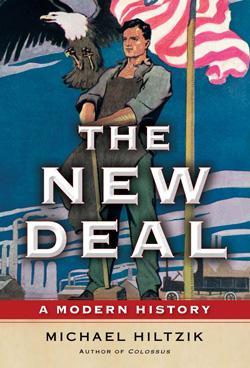What the New Deal Accomplished
651,000 miles of highway. 8,000 parks. The Triborough Bridge. Do conservatives who attack the New Deal actually know what America gained from it?
This excerpt, which is courtesy of the Free Press, comes from Michael Hiltzik’s new book, The New Deal: A Modern History.
During the years of the New Deal, America’s government built as it never had before—or has since.
The New Deal physically reshaped the country. To this day, Americans still rely on its works for transportation, electricity, flood control, housing, and community amenities. The output of one agency alone, the Works Progress Administration, represents a magnificent bequest to later generations. The WPA produced, among many other projects, 1,000 miles of new and rebuilt airport runways, 651,000 miles of highway, 124,000 bridges, 8,000 parks, and 18,000 playgrounds and athletic fields; some 84,000 miles of drainage pipes, 69,000 highway light standards, and 125,000 public buildings built, rebuilt, or expanded. Among the latter were 41,300 schools.
The transformative power of this effort is inestimable. The Tennessee Valley in 1933 was a quintessential backwoods region of “grim drudgery, and grind” in the words of its savior George Norris: beleaguered by floods, drained of its manpower by the siren call of the cities, the latent wealth of its river and lumber left fallow. The TVA of Norris and Franklin Roosevelt turned it into a land of plenty that called its workers home, put its natural endowments to productive use, and delivered to its residents the promise of a secure American middle-class lifestyle.
The Public Works Administration provided Harold Ickes with a larger construction budget than any American government official ever had received: $3.3 billion, more than 20 times the $150 million the government spent on public construction projects in 1929. Ickes was determined to make the most of it. The impression is accurate that he disbursed the money with the tightfistedness of a man spending from his own pocket; but there is no denying that he thereby ensured that it would create for the nation a greater patrimony.
PWA built or helped build monumental projects from sea to sea. In Washington State, Grand Coulee Dam put 8,000 men to work starting in 1933 and used materials and equipment from 46 of the 48 states. In Southern California, PWA helped repair or replace 536 school buildings damaged or destroyed by the great Long Beach earthquake of March 10, 1933. Most of them, rebuilt to the most exacting seismic standards of the time, are still in use at this writing. In Florida, the exemplary project was the Overseas Highway, 127 miles of causeways and bridges connecting the mainland and Key West, built on the remains of a railroad line destroyed by hurricane in 1935, and transforming the latter island from a dismal outback of dispossessed relief recipients to one of America’s premier tourist destinations. In New York was built the greatest project of them all—the Triborough Bridge tying together three of the city’s five boroughs, rescued from insolvency in 1933 by a PWA grant and loan totaling $44 million, and dedicated in 1936 with FDR in attendance despite his loathing for the project’s municipal overseer, Robert Moses, whom the president had repeatedly tried to remove from the project, without success. But he swallowed his enmity for Moses long enough to bask in the nationwide publicity marking Triborough’s completion.
The Triborough ceremony marked a coming of age for the New Deal’s approach to spending for physical infrastructure. At first Roosevelt and his aides had a murky understanding of how to balance the need to put people to work with the goal of efficient and lasting construction. Rexford Tugwell, a top Roosevelt adviser, had witnessed an especially telling exchange between the president and New York Mayor Fiorello LaGuardia about government funding for what would later be christened LaGuardia Airport. “They were happily agreeing that bulldozers and other powered machines should be banned,” he related. “There should be only hand tools so that more men would be employed.” Finally, Tugwell interjected that if they really wished to put the maximum number of men to work, why not confine them to hand trowels? The point was driven home that they might indeed employ more men, but they would never be able to finish one airport, much less build any others.
FDR came to understand the political luster of great public works. When possible, he dedicated them in person—even when, as in the case with the structure that would ultimately be known as Hoover Dam, credit for its construction belonged to his Republican predecessors. Skeptical early in his first term about their cost and utility, he soon became an enthusiast, demanding more plans and more works—more bridges, more dams, even a highway spanning the American continent from sea to shining sea.
A good portion of Franklin Roosevelt’s immortality rests upon the New Deal’s physical works; but even more rests upon its transformation of the nation’s social and economic structures.

Here we must consider Americans’ relationship with what is, after all, their government. The New Dealers did not think about government in the limited terms of their predecessors, as an agency of national defense and little else. They did not perceive it as an antagonist of the common man, an enemy of liberty, or an entity interested in its own growth for growth’s sake. They understood that it was a powerful force and that its power could be exercised by inaction as well as action, to very different ends. The condition of the American people when the New Dealers assumed office demanded ameliorative action, and this they strived to deliver. They did not invariably achieve their goals, but in appraising their performance it is important to acknowledge that the crisis they addressed was uniquely cataclysmic in American history, and that suitable precedent for addressing it simply did not exist.
Federal deposit insurance, by eliminating bank runs even in times of economic crisis, cut the number of bank failures from the peak of 4,000 in 1933 to nine the next year. Bank failures would not exceed 75 in any one year until the savings-and-loan crisis of the 1980s, and for a three-decade stretch beginning in 1943 never exceeded single figures. The importance of this record for depositor confidence and the safety of the nation’s monetary stock is incalculable.
The reforms implemented under the Securities Exchange Act of 1934, which established the Securities and Exchange Commission, professionalized an industry burdened in the aftermath of 1929 with a reputation for insider transactions and sharp dealing. The transparency of financial reporting mandated by the act for public corporations and brokerages set the foundations for the explosive growth of the U.S. capital markets and corporate economy ever since.
The New Deal instilled in Americans an unshakable faith that their government stands ready to succor them in times of need. Put another way, the New Deal established the concept of economic security as a collective responsibility. As of this writing, Social Security, by any measure the outstanding domestic achievement of the Roosevelt administration, serves 54 million beneficiaries. Over the decades the program has kept many tens of millions of American workers and their families out of poverty. The promise of corporate pensions has largely disappeared from the employment contract and the investment markets have disappointed many workers’ expectations of comfortable retirements, but Social Security endures, providing retirees with benefits that grow with inflation and that cannot be outlived. Social Security began as an “awkward and insufficient” program, as Rexford Tugwell would observe; but it was expanded in succeeding decades, under Republican and Democratic presidents alike, in a continuing effort to uphold its original promise. Its 1960s addendum, Medicare, sprang organically from that promise.
The New Deal effectively ended in 1939, amid doubts about Roosevelt’s leadership and under the shadow of war, as a work in progress. To a great extent it is still unfinished.
Bank failures periodically surge because of outbreaks of imprudent management inadequately monitored by federal regulators, as occurred in the savings-and-loan crisis of the 1980s and the financial crisis of 2008. The business reforms of the ’30s have proven unequal to chicaneries of later ages, and periodically must be updated. The physical infrastructure bequeathed by the ‘30s has been allowed in many places to crumble from inattention. The public debate about the proper role of the federal government in Americans’ lives is never-ending, as perhaps it should be. Yet, because the New Deal’s principle of collective security has become so ingrained in the American system, efforts to roll back the programs founded under Franklin Roosevelt almost always seem invested with nostalgia and the scent of unreality. Catastrophe snuffed out the economic and governmental structures of the 1920s and the march of modernity buried them.
Buy Michael Hiltzik’s new book, The New Deal: A Modern History.



No hay comentarios:
Publicar un comentario